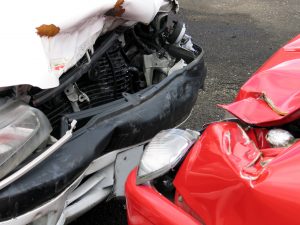What is a head-on collision?
A head-on collision (also known as a frontal crash) occurs when vehicles driving in opposite directions crash into each other. These accidents can be incredibly dangerous because the force of the impact is doubled due to the speed at which both vehicles are traveling. Even if both cars are driving at 30 miles per hour, the force of impact would be equivalent to hitting a brick wall at 60 mph.
And that’s only if both drivers are traveling at exactly the same speed. More often, people drive at different speeds, which can increase the force of impact exponentially.

Many head-on car accidents occur when a driver is traveling on the wrong side of the road, usually because they are drunk or distracted. These situations are examples of the at-fault driver’s negligence, which a car accident lawyer can help prove in court.
Because of the nature of head-on collisions, you should hire an experienced attorney who can determine cause and liability by consulting with accident reconstruction professionals. Call Get Car Accident Money today for a free case consultation.
Who is at fault in a head-on collision?
If you were driving on the correct side of the road, a driver on the incorrect side of the road will be at fault. The at-fault driver’s insurance will need to pay for your injuries and vehicle damage.
However, although liability may seem obvious in these cases, you should still obtain as much evidence as you can, both at the scene of the accident and in the following weeks. Evidence will help validate your claim and strengthen your case against the other driver. At the scene of the accident, try and get:
- Photos of any physical or property damage. Injuries to your person, damage to your vehicle, etc.
- Photos of the accident scene. Try and document the position of your and the other driver’s vehicles, as well as any marks on the road and traffic signs.
- Witness information. Before you leave the scene of the crash, find witnesses and obtain their contact information. You may need their phone numbers or email addresses for correspondence with your insurance company or car accident attorney to help build your case.
In the days or weeks after the accident, try and get the following:
- Medical records. If you suffered an injury from a head-on collision, obtaining medical records can help prove that your injuries resulted from the accident and were not preexisting.
- Police report. When the police arrive at the scene of a car accident, they create a report with essential facts about the crash including date, time, and people involved, as well as their opinion of who was at fault.
Whether you decide to take your case to trial or not, a jury or insurance carrier will look for the following to determine fault in a head-on collision:
- Negligence. A driver is negligent if their actions were contrary to what is expected of a reasonable driver. That is, following traffic laws such as entering an on-ramp correctly or driving in the correct lane on the correct side of the street.
- Duty of care. Drivers must follow the law and operate their vehicles with reasonable care. If a driver is distracted or under the influence of alcohol or drugs, they are not exercising duty of care, which your attorney can prove in court or to the insurance carrier.
- Cause. If you are making a personal injury claim following your head-on collision, you will need to prove that your injuries were a direct result of the other driver’s actions.
Head-On Collision Injuries
In 2018, more than 256,000 people were injured in head-on collisions. Because of the force of impact between the victim’s vehicle and the at-fault driver’s vehicle, these crashes can result in life-threatening injuries. If you have been injured in a head-on collision, you already know how steep medical bills can be – let Get Car Accident Money represent you and recover the compensation you need.
The following are common injuries associated with head-on collisions:
- Head and neck injuries. Unlike rear-end accidents, those involved in a head-on collision are thrown forward into the airbag, seatbelt, or windshield. The force of this impact can cause traumatic brain injuries, like a hematoma in or around the brain, or whiplash. Whiplash is an injury caused by violent jerking to the neck that leads to pain, headaches, stiffness, dizziness, and blurred vision.
- Spinal injuries. The force of impact behind the head-on collision can cause spinal discs to herniate or rupture, leading to severe pain and even partial or total paralysis.
- Internal injuries. Because the passengers in a head-on collision are thrown forward into a seatbelt restraint or deployed airbag, the force of impact can lead to internal organ damage and bleeding. Commonly affected organs are the liver, spleen, lungs, and kidneys.
- Facial injuries. If a victim is thrown forward and hits the car dashboard, steering wheel, or other hard surface in the vehicle, they can suffer from a range of facial injuries, some of which need plastic surgery to treat. Common facial injuries from a head-on collision including damage to the eye sockets, chin, jawbone, and cheekbones.
Contact Get Car Accident Money Today
Head-on collisions are serious and often deadly accidents. Unfortunately, many of these crashes result from a driver’s negligence or failed duty of care.
If you were injured in a head-on collision and believe the other driver was at fault, contact an experienced car accident lawyer today. Get Car Accident Money will work with you to build your case and recover the compensation you need to pay medical bills and related expenses. You were the victim of a traumatic collision – let Get Car Accident Money help you.